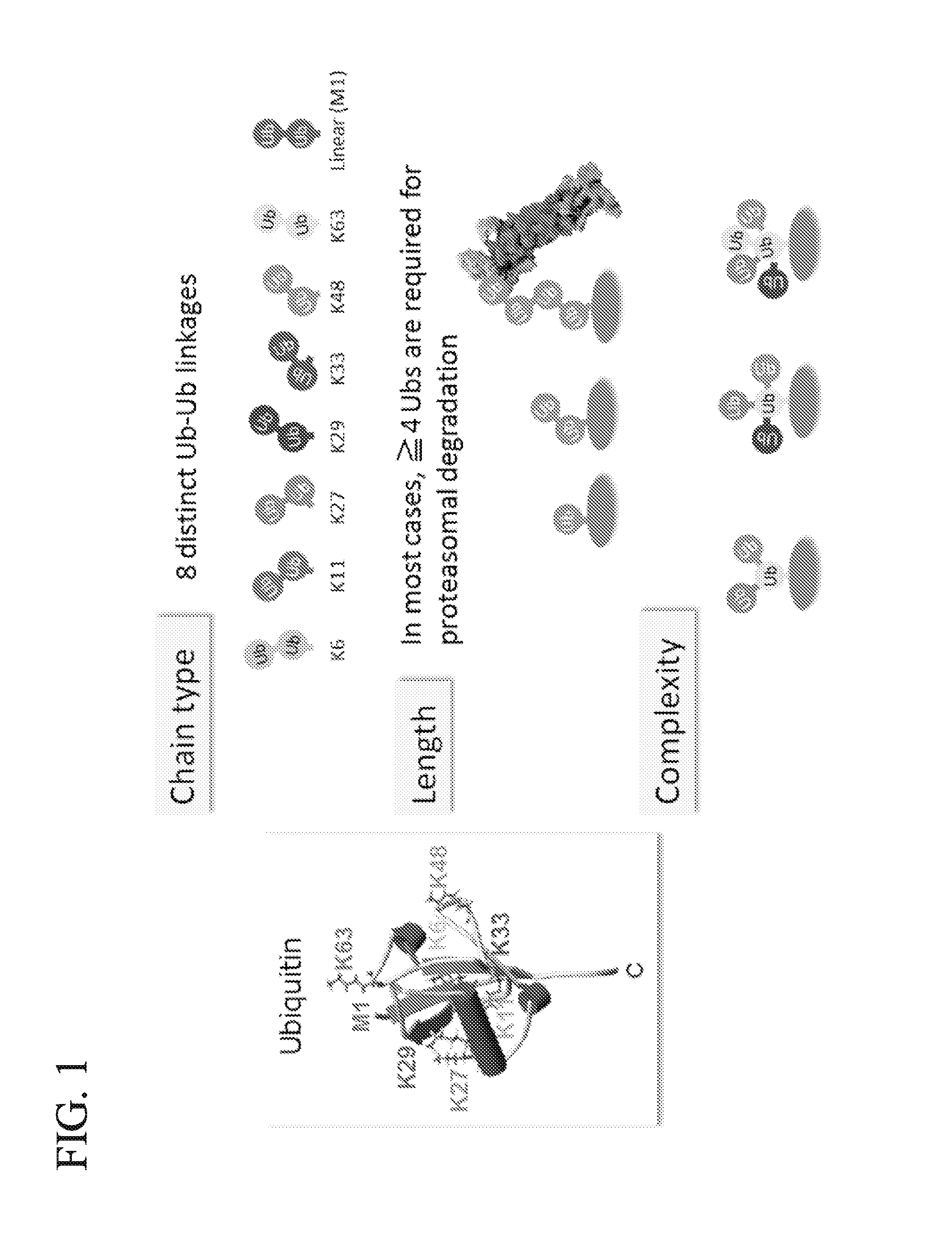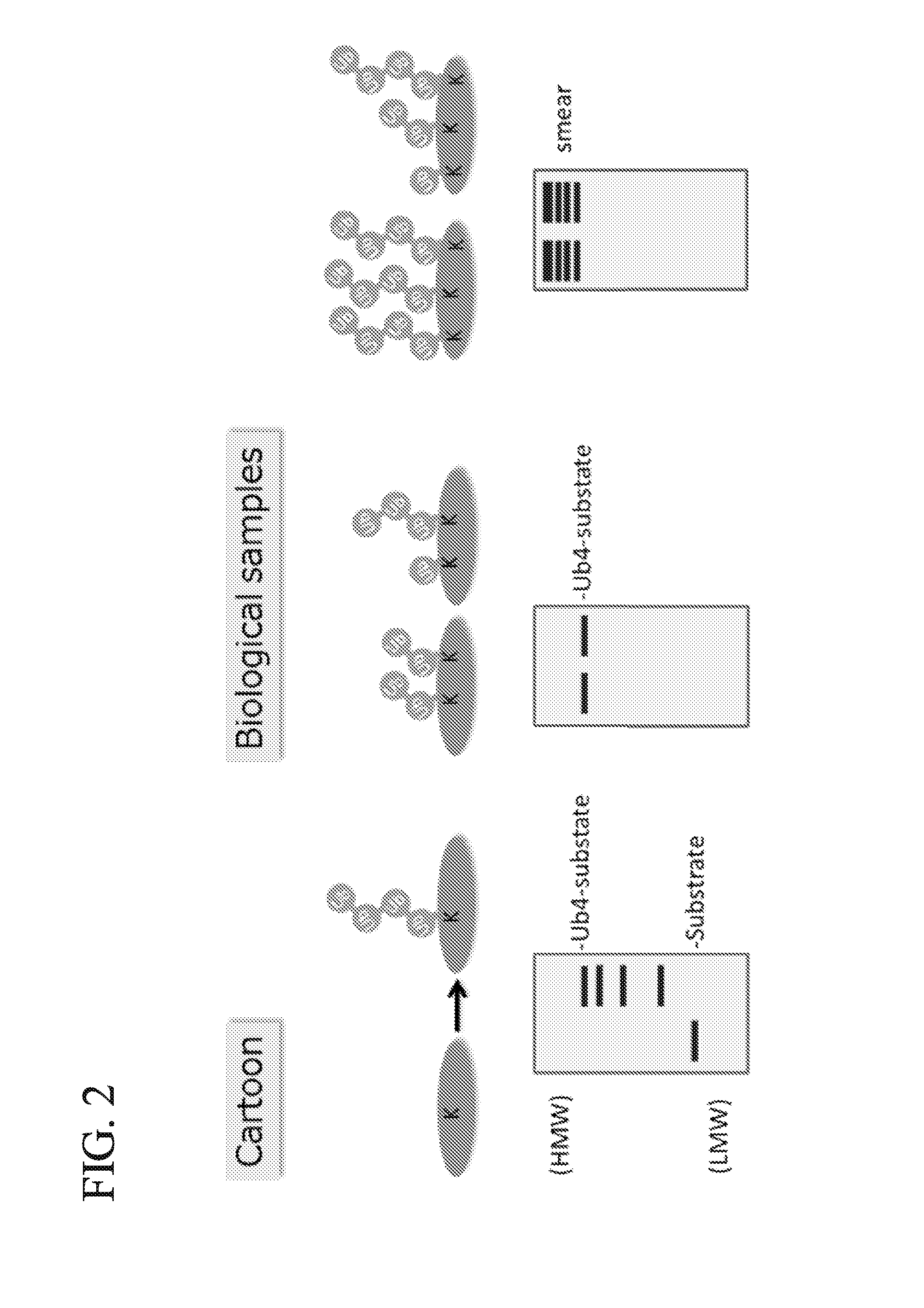Method for Determining Ubiqutin Chain Length
- Summary
- Abstract
- Description
- Claims
- Application Information
AI Technical Summary
Benefits of technology
Problems solved by technology
Method used
Image
Examples
example 1
A Method for Measuring Polyubiquitin Chain Length
[0046]The method of the present invention is based on the trypsin sensitivity of polyubiquitylated proteins. When polyubiquitylated proteins are subjected to trypsinization under native conditions, the substrate proteins are almost completely digested, but the polyubiquitin chains are partially digested or only cleaved at Arg74 of ubiquitin molecules, by which a signature peptide containing a di-Gly remnant of ubiquitin is produced (FIG. 3a). However, in the presence of a high-affinity probe for polyubiquitin chains, substrate-attached chains are protected from trypsinization; thus, the inventors of the present invention named the method ‘ubiquitin protection from trypsinization’ (Ub-ProT) (FIG. 3b). For the probe, the inventors of the present invention modified a previously reported high-affinity probe for polyubiquitin, tandem ubiquitin binding entity (TUBE) (EMBO reports 10, 1250-1258, (2009)). The original TUBE construct consists ...
example 2
Steady-State Units of Polyubiquitin Chains
[0049]The inventors of the present invention next investigated the mean lengths of substrate-attached polyubiquitin chains in yeast lysate. To the knowledge of the inventors of the present invention, the actual chain lengths of polyubiquitylated proteins in vivo have not been previously determined. In this experiment, the inventors of the present invention used a drug-sensitive pdr5 mutant to determine the effect of a proteasome inhibitor, MG132. Exponentially growing cells were lysed with glass beads in the presence of MG132 and iodoacetamide in order to inhibit deubiquitylating enzymes. Ubiquitylated proteins in the lysate were captured and pulled down by TR-TUBE using the biotin tag. The patterns of ubiquitylated proteins were quite similar between lysate and TR-TUBE-captured proteins, with the exception of ubiquitin monomer, suggesting that TR-TUBE can capture all endogenous ubiquitylated proteins other than ubiquitin monomer (FIG. 8a, l...
example 3
Effect of Proteasome Inhibitor on Chain Length
[0051]The inventors of the present invention also analyzed proteasome inhibitor-treated cells by Ub-ProT. After treatment with 100 μM MG132 for 4 h, ubiquitylated proteins accumulated in the cells (FIG. 8a, lanes 1 and 2). Surprisingly, the Ub-ProT assay suggested that signal intensities of the ubiquitin ladder were increased, but the chain length was not changed (FIG. 9a, left). The inventors of the present invention quantitated the ubiquitin linkages from the ubiquitin ladder; compared to untreated cells, proteasome-inhibited cells accumulated all types of linkages. K6-, K29-, and K48-linked chains accumulated at high levels, but their length distributions were unchanged. Furthermore, long K11- and K63-linked chains accumulated slightly in the proteasome inhibitor-treated cells (FIG. 9c). It will be of great interest to determine whether the long K11- and K63-linked chains are homogeneous. Collectively, these results suggested that mos...
PUM
| Property | Measurement | Unit |
|---|---|---|
| Fraction | aaaaa | aaaaa |
| Electrical resistance | aaaaa | aaaaa |
| Flexibility | aaaaa | aaaaa |
Abstract
Description
Claims
Application Information
 Login to View More
Login to View More - R&D
- Intellectual Property
- Life Sciences
- Materials
- Tech Scout
- Unparalleled Data Quality
- Higher Quality Content
- 60% Fewer Hallucinations
Browse by: Latest US Patents, China's latest patents, Technical Efficacy Thesaurus, Application Domain, Technology Topic, Popular Technical Reports.
© 2025 PatSnap. All rights reserved.Legal|Privacy policy|Modern Slavery Act Transparency Statement|Sitemap|About US| Contact US: help@patsnap.com



